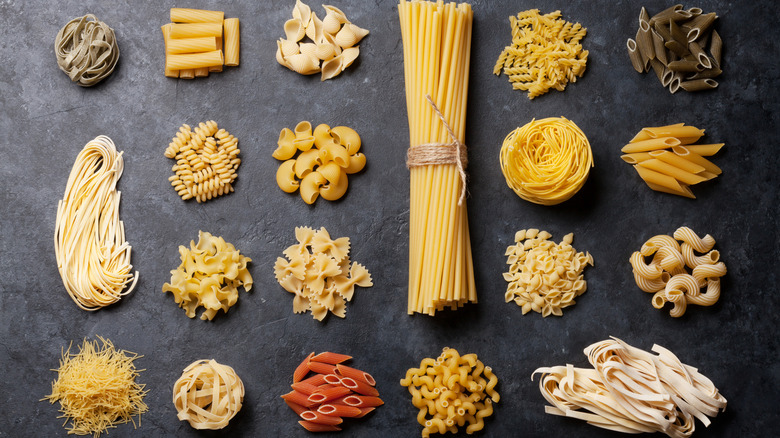Here's How Spaghetti Got Its Name
The origin of spaghetti is shrouded in folklore and myth. Some assert that all pasta is undoubtedly Italian, as it comes from the Italian word for paste or dough and is an integral part of modern Italian cuisine and culinary identity. However, it's been rumored that pasta evolved from Chinese noodles via Marco Polo's expeditions to East Asia in the late 13th century, according to Best of Sicily Magazine. Though noodle dishes had been in Asia long before spaghetti was even on a menu, historical evidence suggests pasta (in its derivative form) was consumed in the Mediterranean well before Marco Polo made his first voyage.
The Atlantic refers to recorded rulings in a fifth-century Jerusalem Talmud on the kosher-ness of boiled noodles called itriyah, later popularized through the Arab empire by the 10th century. However, Italian historians cite Italy as the ancient pasta progenitors, given images that resemble pasta-making tools found on the façade of a fourth-century B.C.E. Etruscan tomb. But this claim is disputed by archeologists and academics due to the lack of noodle tools during the Roman empire. The prevailing origin theory (according to BBC Radio 4) is that durum wheat (hard wheat) was introduced to the island of Sicily in the 12th century during the Arab conquest. By 1154, geographer Abu Abdullah Mohammed al Idrisi completed his publication "The Book of Roger," which recounts Sicily's infatuation with pasta in the form of long, string-like noodles (via Best of Sicily Magazine).
The name of a noodle
Thankfully, spaghetti's etymological origin is slightly less convoluted than its culinary history. Like most Italian pastas, spaghetti's name refers to the distinctive shape or feature of the pasta. The culinary site Butter-n-Thyme tells us that noodles like conchiglie and farfalle literally translate to shells and butterflies to describe their obvious shapes, and tubular bucatini noodles get their name from the Italian word for hollowed. The word spaghetti is actually the plural version of the word spaghetto, meaning string or twine (according to the Online Etymological Dictionary).
Even within the spaghetti family, there are derivations that indicate thickness. Linguistically, the "-etti" or "-ette" suffix means "little" or "cute," hence why spaghetti (strings) refers to something thinner and smaller than cords (spago), per Quattro Formaggi. Additionally, the suffix "-ini" indicates "small," while "-oni" implies "large." Thus, spaghettini refers to strings that are thinner than the baseline, whereas spaghettoni is a noodle that is thicker than regular spaghetti. Though the culinary origin of the dish may be obscured, it's unquestionable that the name for spaghetti is Italian through and through.
Spaghetti beyond Italy
Given spaghetti's renown as a classic Italian pasta, it was only a matter of time before it was adapted and assimilated into the cooking cultures of America and Britain. The U.K.'s favorite spaghetti dish is called the spag bol — short for spaghetti Bolognese — which is essentially pasta with meat sauce. The Italian interpretation of this dish features a more ribbon-like tagliatelle with a slow-cooked meat sauce, but as the U.K. had more Italian culinary influence post-World War II, the dish evolved to make use of available canned ingredients and minced beef. Over time, the spag bol's popularity in Britain eclipsed its Italian counterpart, to the point where a tourist ordering a spag bol in Bologna today would be met with confusion, BBC Radio 4 tells us.
In the U.S., one of the most iconic Italian pasta dishes is spaghetti and meatballs, but this is another case of people immigrating from Italy, bringing their food culture and adapting it to fit the new culinary landscape. In the early 1900s, meatballs weren't as much of a staple in Italian cuisine, but America had a very meat-centric diet (via The Atlantic). Modern spaghetti dishes were adapted out of necessity during the Great Depression and to accommodate the American palate. Noodles may be a ubiquitous part of food cultures everywhere, but pasta, as we know it in America, is heavily influenced by Italian foodways that have been adapted over generations, and the names of these dishes still harken back to their traditional roots.


